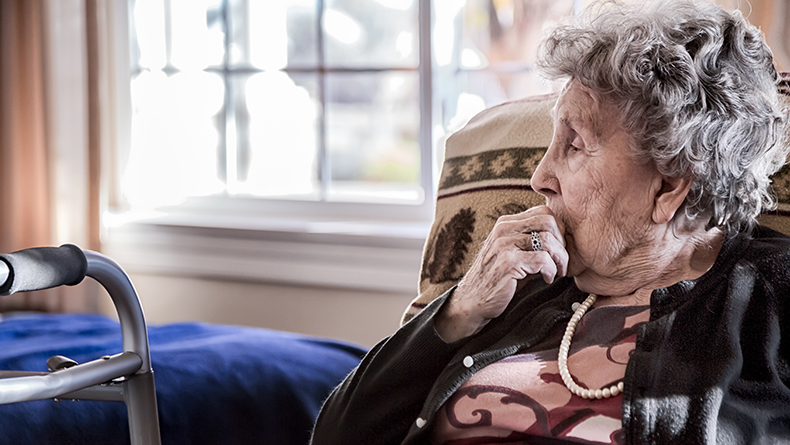AARP Hearing Center
The COVID-19 Imperative: Keep Family Caregivers and Long-Term Care Facility Residents Connected
By Edem Hado, Lynn Friss Feinberg, April 7, 2020 02:49 PM

In the face of the outbreak, AARP is providing information and resources to help older people and those caring for them protect themselves from the virus and prevent it from spreading to others. You can find AARP's coronavirus resources at www.aarp.org/coronavirus.
As individuals, families, and communities continue to confront the novel coronavirus (COVID-19), we are reminded just how connected we are—and how much we depend on one another to keep going. Consistent with that truth, family caregivers can serve as crucial and trusted partners in the nation’s strategy to curb the spread of the disease, and help the people they care for to cope with the stress and anxiety of this unprecedented situation.
Just on an average day, family caregivers are often the critical factor that enable older adults and people with disabilities who need long-term services and supports (LTSS) to live at home and in the community. As an older adult’s care coordinator and primary advocate, family caregivers oftentimes become the “eyes and ears” for the concerns and safety of the care recipient with complex care needs, including when their loved one resides in a long-term care facility. Family caregivers are invaluable—and in a unique position to better understand, articulate and support the emotional, social, and health needs of the care recipient.
This becomes all the more important in a public health emergency such as the current pandemic. And yet with the pandemic, connecting with their loved ones in such facilities as nursing homes and assisted living settings has become more difficult.
Family Caregiver Role Grows with Crisis
To slow the spread of COVID-19 to vulnerable older adults in long-term care facilities, the federal Centers for Medicare & Medicaid Services (CMS), which regulates most skilled nursing homes, has issued strict guidelines on visitation to nursing homes. Most assisted living facilities not regulated by the federal government are also limiting or halting visitors to their facilities.
Even if physical visits are not possible, the guidelines should not inhibit relationships and connections between residents and their family members and close friends, which are crucial to one’s well-being—both physical and emotional. Family caregivers of nursing home residents, and those living in assisted living facilities, should monitor the health and well-being of their loved ones as closely as possible.
In addition—and somewhat paradoxically—in spite of the unique challenges that protecting older individuals from COVID-19 presents, the current situation makes meaningful connection all the more important. It is essential for residents and family members to be able to communicate and visit virtually, especially during times of stress—such as this one. The health impacts of social isolation are real and very serious.
Solutions to Meet the Challenge
Enabling the relationship between the family and care recipient to thrive through this crisis takes action in multiple areas:
Strengthening nursing home-family caregiver communication channels. In the updated guidelines, CMS is encouraging nursing homes to keep residents’ loved ones informed about their care. CMS should strengthen this measure by requiring nursing homes to do so. One way that facilities can achieve this is by assigning staff members as primary contacts for families (e.g., the designated family caregiver or representative) to facilitate regular communications with staff by telephone, email or video. Facilities should also facilitate ways for family caregivers to stay in touch with their loved ones—through, for example, regular phone and “virtual visitation” (e.g., Face Time, Skype, Zoom). This should include facilitating conversations with residents and their family caregivers about treatment options and putting advance care plans in place.
Activating family councils. Federal regulations give family caregivers of nursing home residents the right to be part of a family council and meet together on site in the nursing home to advocate for residents and partner with staff to improve quality of care. During this public health emergency, facilities should facilitate alternative means of communication for family councils (using email, Skype, or “phone trees”) to exchange information and for family members to support one another and stay informed.
Enabling alternative communication solutions. States can also play an important role. They should encourage specific communication workarounds for residents and families as they put in place visitation limitations. These might include processes for staff to facilitate phone calls, making video-enabled devices available to facilities, and requiring more frequent facility communication with families. A state’s long-term care ombudsman may be able to help facilitate this effort.
A Final Word: Care of Self
Finally, a word on family caregivers themselves. They need to manage their own health, stress, and well-being, and so it is important for family caregivers to be aware of this, and for anyone who knows a caregiver—from LTSS and health care professionals to friends—to underscore the importance of self-care with them. A long-term care facility restricting access to a loved one, while done for the good reason of protecting them from the spread of the disease, inherently creates added stress and anxiety. Joining online support groups, including AARP’s Family Caregivers Discussion Group on Facebook, can help foster the sharing of information and advice and provide encouragement.
In this time of unprecedented challenges, it is imperative that we do not lose sight of the crucial need to ensure family engagement, communication, and inclusion in all settings of care, particularly in long-term care facilities.

































































